In early modern Europe most of what passed for social welfare was organized and run by confraternities, or lay brotherhoods. An extension of the Church system, membership consisted of upper-class men and women who ran the city’s hospitals, hostels, orphanages, eldercare facilities, and shelters for prostitutes and widows. They also managed the distribution of food, medicine, alms, and dowries to the poor—all in the name of Christ.
In 1504 in Alkmaar, Netherlands, one such confraternity, the Holy Ghost Confraternity, commissioned a polyptych for the city’s parish church of St. Lawrence. Its panels are based on the group’s founding principles laid out in Matthew 25:31-46, where Jesus says that those who will inherit the kingdom of God are those who feed the hungry, give drink to the thirsty, welcome the stranger, clothe the naked, care for the sick, and visit the prisoner. “As you did it to one of the least of these my brothers,” Jesus says, “you did it to me.”

In Catholic tradition these six imperatives are combined with burying the dead (Tobit 1:16–22) to codify what’s known as the Seven Corporal Works of Mercy, aimed at alleviating physical suffering. Northern Renaissance artists were especially keen on the subject, most famously the anonymous Alkmaar master who painted these seven panels. His The Seven Works of Mercy shows an idealized Alkmaar where needs are met through confraternal charity—families out of work and those with disability are fed and clothed, sojourners are given lodging, the sick are nursed to health. The paintings provide an ethical model to imitate and, more than that, illuminate the profound biblical notion that the afflicted bear God’s own face, as among the crowds in each scene is Jesus himself.
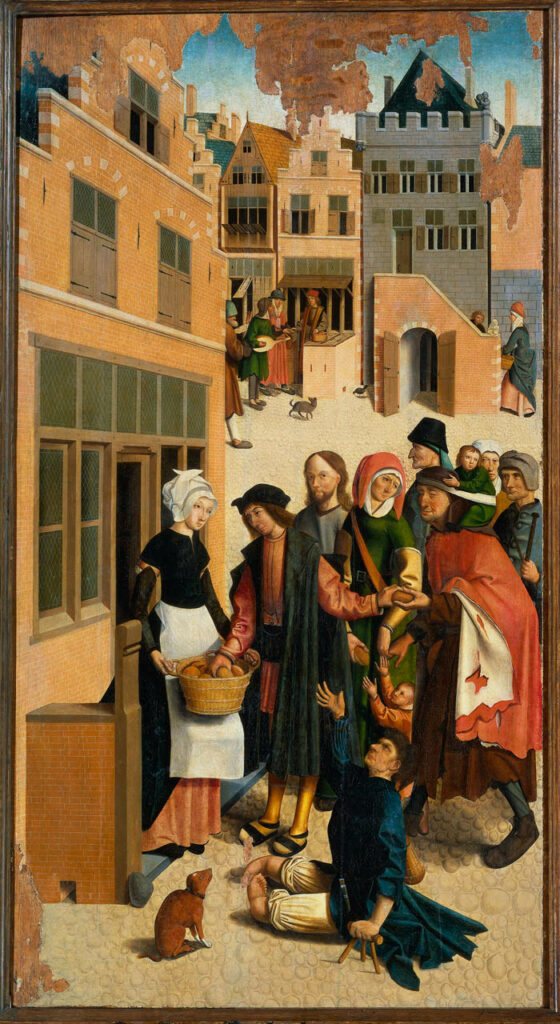
Feeding the hungry
In the far-left panel, a well-off couple distributes bread to the poor who gather at the door of their home. The husband gives a loaf to a blind man in a tattered cloak who has a child on his shoulders, another at his knee, and a wife who tenderly holds his hand. On the ground beside them is a man with a clubfoot who scoots forward with his crutch. Among the hungry is a man in gray who stares straight out at the viewer. It’s Jesus. His arresting gaze seems to say, “If you don’t see the hungry, you don’t see me.” Or, “If you don’t love and serve your neighbor, you don’t love and serve me.” As we examine the painting, it examines us.
In each of the seven panels, the merciful act in the foreground is mirrored on a smaller scale in the background. In this background vignette, a figure offers bread to a wandering minstrel. More intriguing though is the child who sits on the steps of the adjacent home, approached by a charitable woman who has finished her rounds. Some have supposed he’s an orphan. But I wonder if maybe he’s the woman’s son, a person of privilege who sits apart from the receiving throngs, perhaps curious at their class difference, even sympathetic, but too scared to engage.
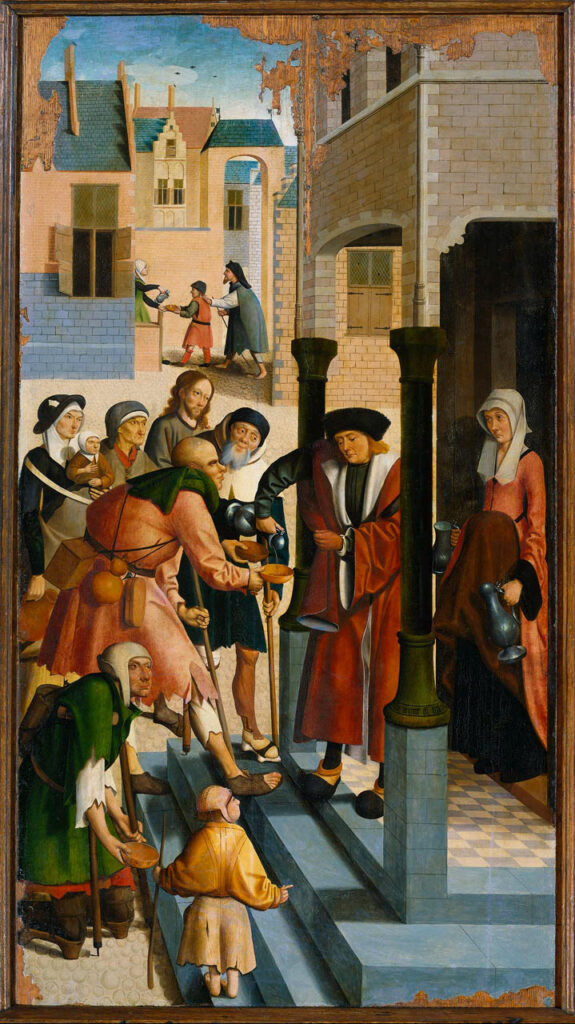
Giving drink to the thirsty
A burgher couple pours water from their silver pitchers into the empty bowls of passersby, including a person with a spinal deformity and another with a leg injury.
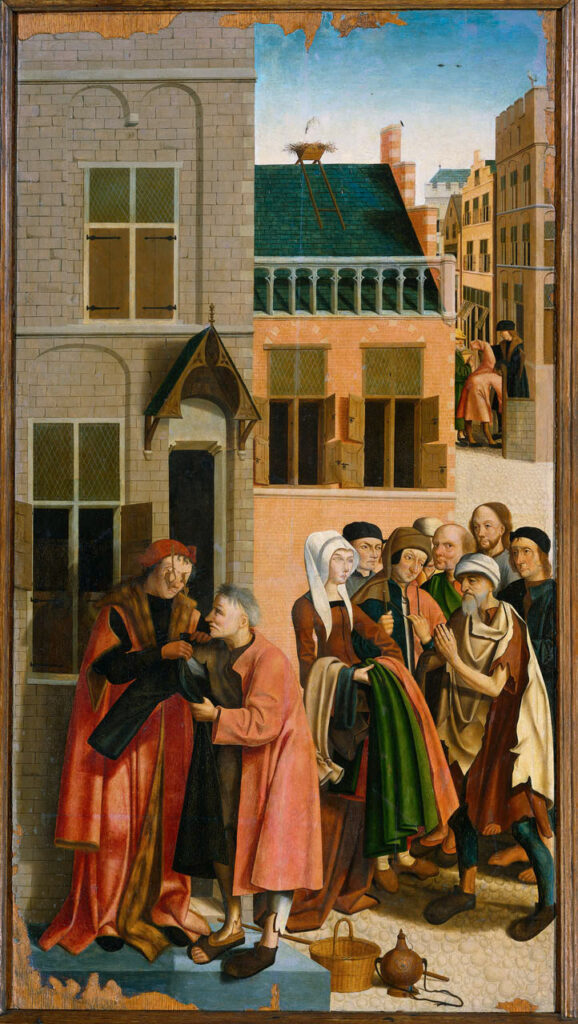
Clothing the naked
People receive jackets and other articles of clothing. Again, Christ is on the side of the afflicted.
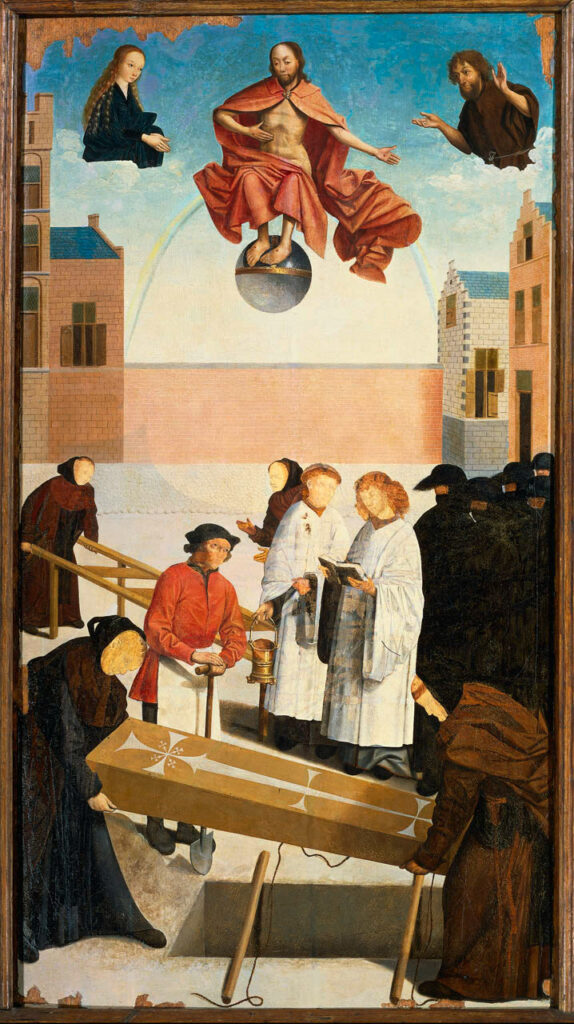
Burying the dead
In the central panel it is the clergy who are in action—anointing a body, transporting the coffin, digging a grave, performing funeral liturgies. To the right is a group of mourners dressed in black. Jesus’ presence is the most explicit in this panel: he’s seated on a rainbow, the earth is his footstool, and he’s flanked by his mother Mary and by John the Baptist, who intercede. This is an iconography of the Last Judgment, chosen by the artist because of the way Matthew’s gospel expresses the eternal implications of our choice to care for those in need, or not. Notice how Christ cups his side wound, from whence all mercy flows.
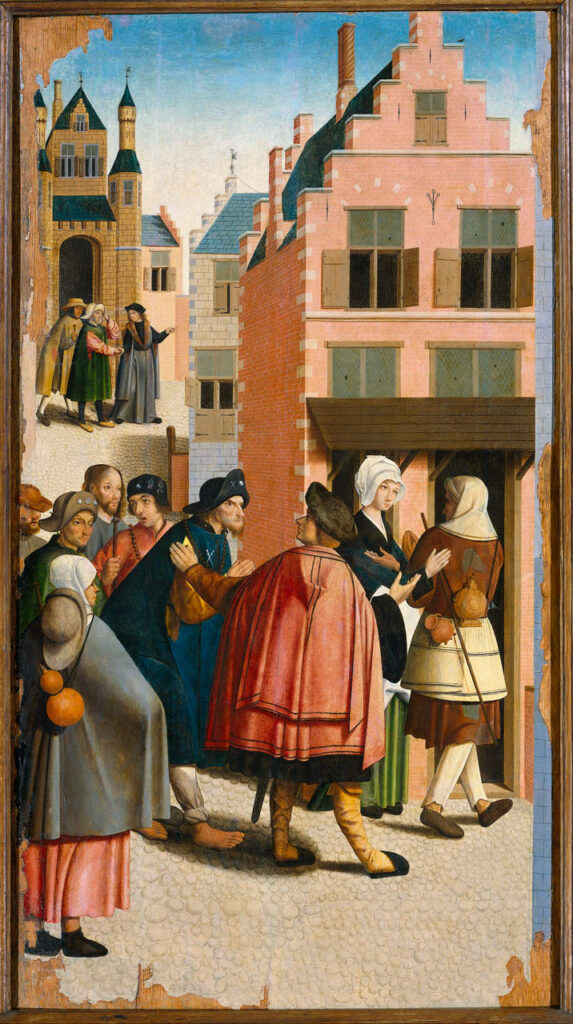
Welcoming the stranger
This work of mercy has to do with extending hospitality to those you don’t know, especially receiving foreigners—out-of-towners, border-crossers—into your home. The Alkmaar master portrays the “strangers” as pilgrims, as indicated by the badges on their hats. They are given rooms to stay in.
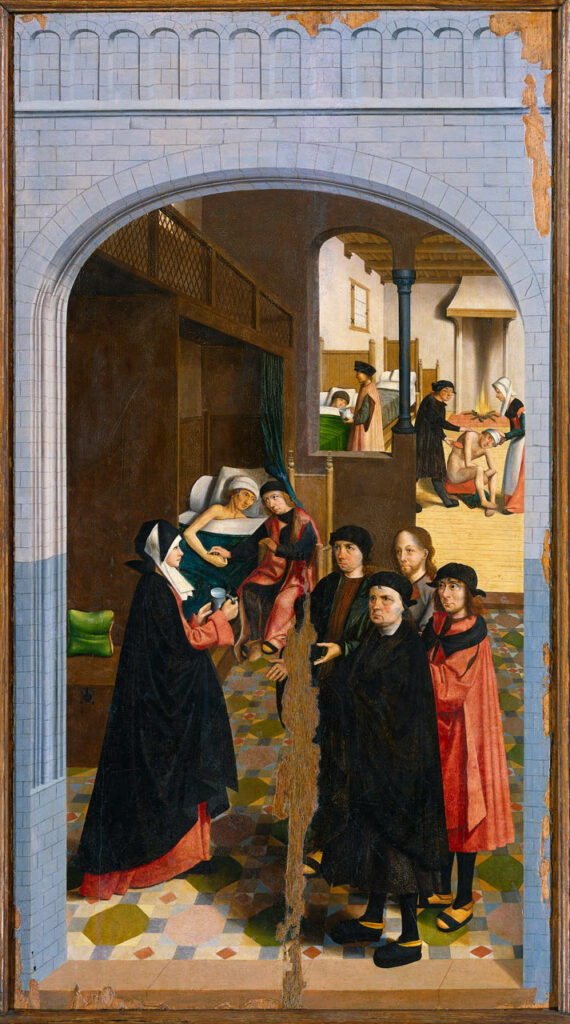
Caring for the sick
Members of the Holy Ghost Confraternity subsidized and maintained the hospice, or almshouse, in Alkmaar, keeping doctors, surgeons, and nurses on retainer to care for the ill and the dying (a different wing housed travelers). In this scene physicians take the pulse of a patient, apply a salve to another’s back, and bring water to one who’s bedridden. Three confraternity members, who scholars suggest are probably the donors of the paintings, approach the hospital to request a spot for a new patient, who happens to be Jesus.
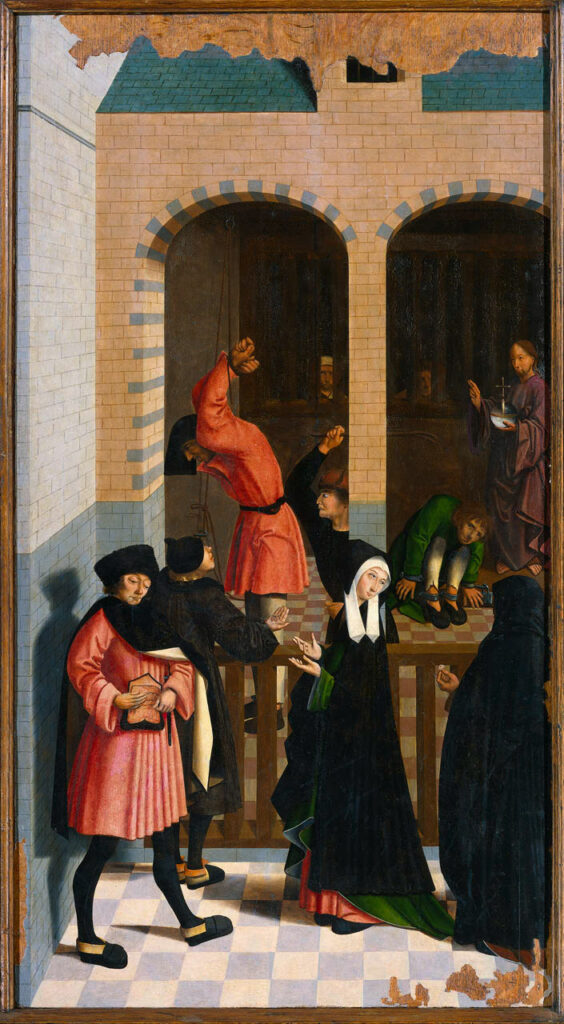
Visiting the prisoner
The final scene is set in a prison, where one man sits in shackles as another is being brutally whipped. Visitors in the foreground plead with the punisher to stop, even offering him money to do so. One woman turns away, unable to look, her palms upturned in prayer for mercy. Most likely the prisoners are debtors, and these good-willed citizens wish to pay off what the men owe, thus buying them their freedom.
In the right midground Christ stands as Salvator Mundi, “savior of the world”; he knows what it’s like to be tortured and condemned, for he paid humanity’s debts with his life. He holds a globe in one hand and makes a blessing gesture with his other. His blessing extends across the entire polyptych, outward to all those who suffer, and to all who are merciful.
This multipaneled painting hung inside St. Lawrence, probably near the Holy Ghost collection box, for three and a half centuries before being acquired by the Rijksmuseum in 1918. It was meant to inspire the practice of Christian virtue through tangible acts of mercy, or through financial support of a group resourced and organized to carry out those acts. But Christ’s appearance among the poor would have not only challenged the bourgeoisie to open their purses, but also reminded the poor, who were among the original audience, that they are blessed and that Christ is present with them.
As with much Renaissance art, the commission was not without an element of self-interest. The paintings acted as a public statement of the confraternity’s identity, highlighting the benefits their presence brought to Alkmaar and its inhabitants, and as a communication of its members’ status. However, the flattery of the do-gooders seems to me not to detract from the work’s impact.
What I find more problematic are the Dutch rhyming couplets inscribed along the bottom frame, which seem to suggest that the promise of reward in heaven should be our primary motivator for performing good deeds. For example, under the second panel is Van spijs ende drank in dit leven / Duisentfout zal u weder warden gegeven (For food and drink given in this life, a thousandfold shall be returned to you). Under the seventh, Die gevangenen verlost met caritaten / Het komt hiernae Uwer zielen ten bate (If you liberate prisoners out of charity, your soul will benefit at the Second Coming).
The Matthean text does promise eternal life to those who treat the marginalized with benevolence and compassion, and warns of “eternal punishment” for those who don’t. And the idea of heavenly reward is found in other New Testament scriptures. But true charity must operate outside the economy of “give to get.” Love expressed in acts of mercy should be for the Christian a natural overflow of the love of God in Christ that we’ve experienced, an outworking of the Spirit who is renewing our sight, wills, and desires. It’s notable that the namesake of the confraternity, the third person of the Trinity, is pictured throughout the panels not as a dove or as tongues of flame as in other biblical narratives, but as the hands of the church feeding, refreshing, warming, beckoning, soothing, praying, grieving, ransoming.
+++
What might the Seven Works of Mercy look like in the twenty-first century? That’s what Dutch photographer Thijs Wolzak sought to explore in his 2010 Works of Mercy project, commissioned by the church of St. Lawrence in Rotterdam as part of a larger permanent exhibition called “A Monument Full of Stories.” Known locally as the Laurenskerk, the church is the only remnant of the medieval city, since the rest was destroyed in the German bombing of 1940; it is preserved as a heritage museum and functions as an important civic space for meetings, presentations, concerts, lectures, exhibitions, and other events. Though it is used for Christian worship on Sundays, the building is primarily for the larger Rotterdam community, and its art reflects that inclusivity.
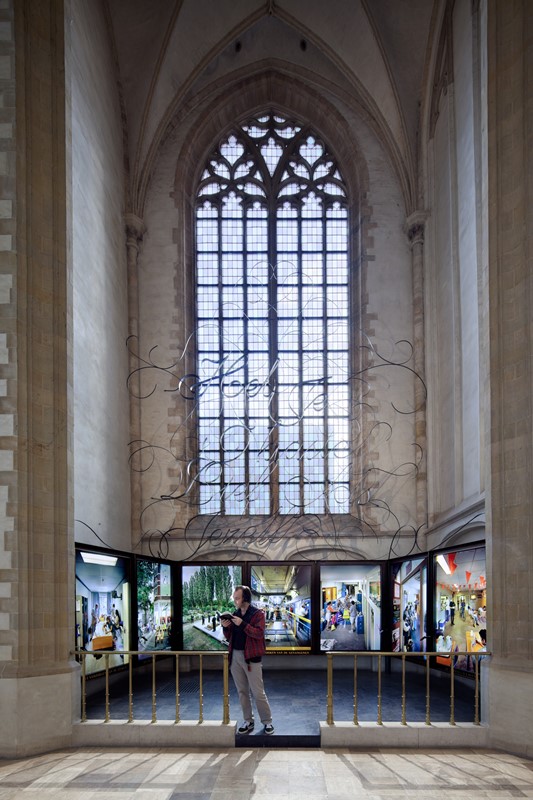
Installed in a side chapel, Wolzak’s Works of Mercy comprises seven photographs of locals enacting The Seven Works of Mercy in their community, such as caring for immigrants, the unhoused, drug users, and others. The photos are staged and directed, but the people in them are actual caregivers and care receivers who portray themselves, having granted permission to have their likenesses captured. The featured locations around the city were chosen by Kathelijne Eisses of the design agency Kossmanndejong, who also came up with the idea of an updated version of the Works of Mercy modeled loosely on the Alkmaar polyptych. Wolzak’s photographs are set inside a framework of LED lightboxes inscribed with the traditional names of the Seven Works in Dutch, and the metalwork lettering above the frame reads, Heb je naaste lief als jezelf, “Love your neighbor as yourself” (Matt. 22:39; cf. Luke 10:27).
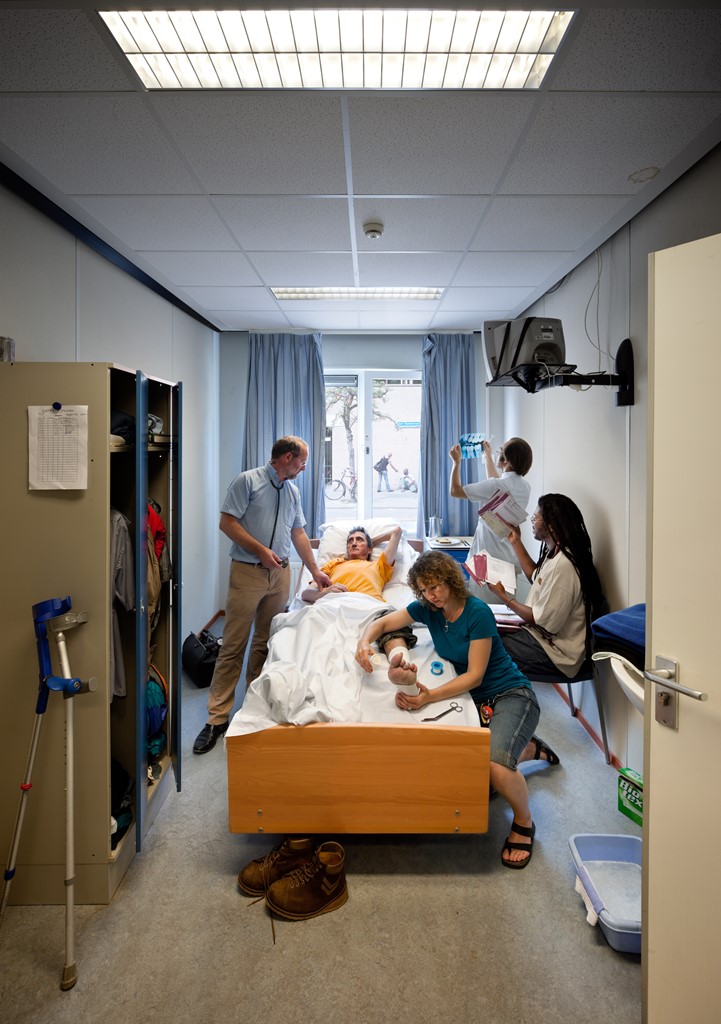
Caring for the sick
Wolzak arranged the Works in a different order than the Alkmaar master had. His first photograph was taken at Havenzicht, a modern corollary to the Holy Ghost Hospice. Havenzicht welcomes people from off the street, providing them with “bed, bread, and a bath” as well as a team of care providers. Here you have a doctor checking the patient’s heart rate, a nurse bandaging the sores on his leg, a dentist examining his dental X-rays, and an administrator helping him address the tickets and fines on his record.
The artist plays with the use of perspective that was such a key element in his prototype, showing consecutive moments in time unfolding in two different planes within one image. Through the window in the background a caregiver attends to a homeless man, asking him to come to the hospital to be taken care of.
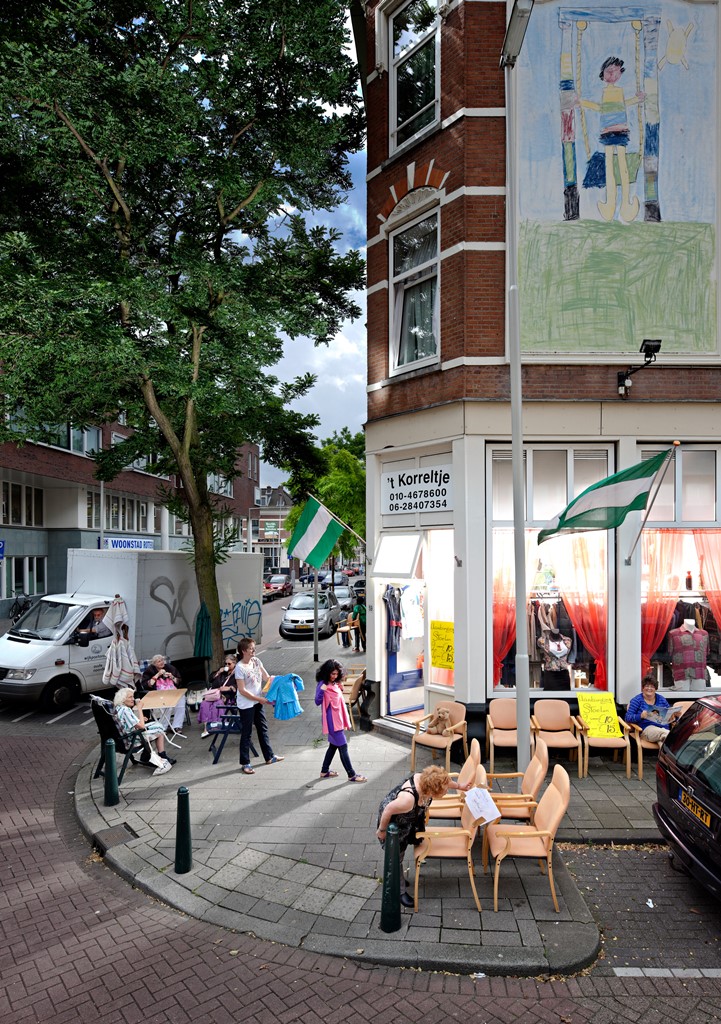
Clothing the naked
’t Korreltje is a secondhand store in the Oude Noorden neighborhood of Rotterdam. It was founded by a local pastor as part of a larger initiative to empower the poor, as it’s often better for your self-esteem to buy something than to be given it. Similar to Goodwill in North America, the store sells gently used clothing and household items at low prices.
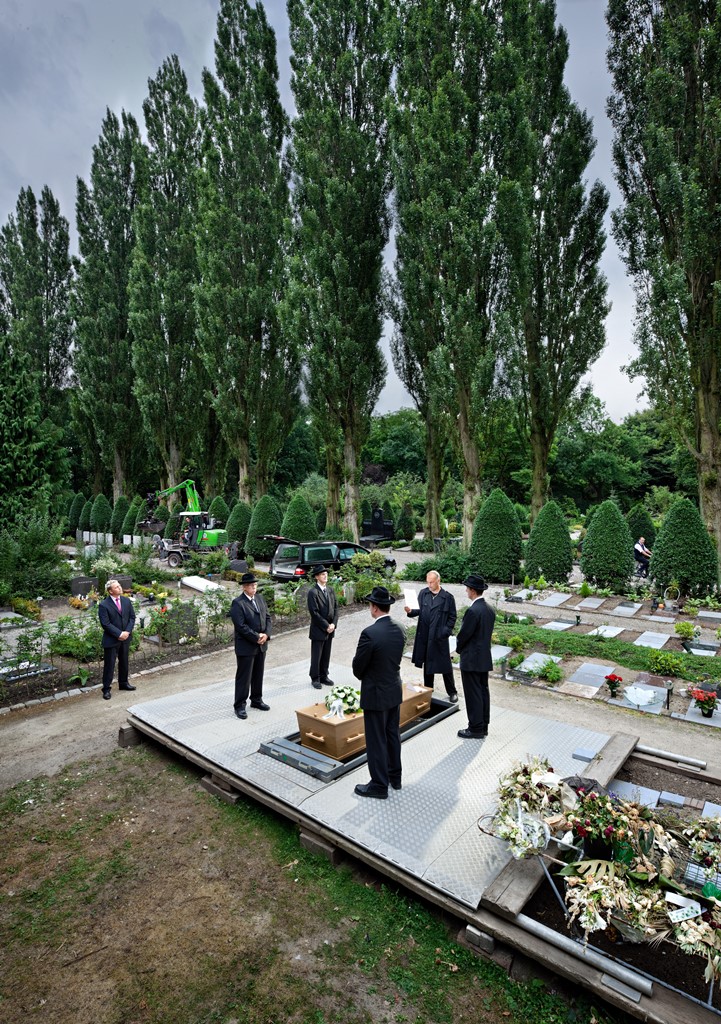
Burying the dead
In the Netherlands, when a person dies anonymously—that is, they have no friends or family to claim their body—the local government pays for a simple funeral and burial. Although a clergyperson presides over these ceremonies, they are usually not tailored to the deceased due to lack of information.
In 2001 the Dutch poet Bart F.M. Droog wanted to bring a more personal touch to these so-called “lonely funerals.” He believed that no one should leave this world unremarked, so he founded De Eenzame Uitvaart (The Lonely Funeral Foundation). The foundation maintains a pool of volunteer poets who are assigned to write a custom poem in honor of the anonymous deceased. Because so little is known about the person, the poets often act as detectives, talking to neighbors, researching the individual’s place of origin, observing what tattoos they have, if any—anything that will give the poet clues as to who that person was in life. The poet attends the funeral and recites his or her poem, then places it in the coffin before it’s lowered into the ground.
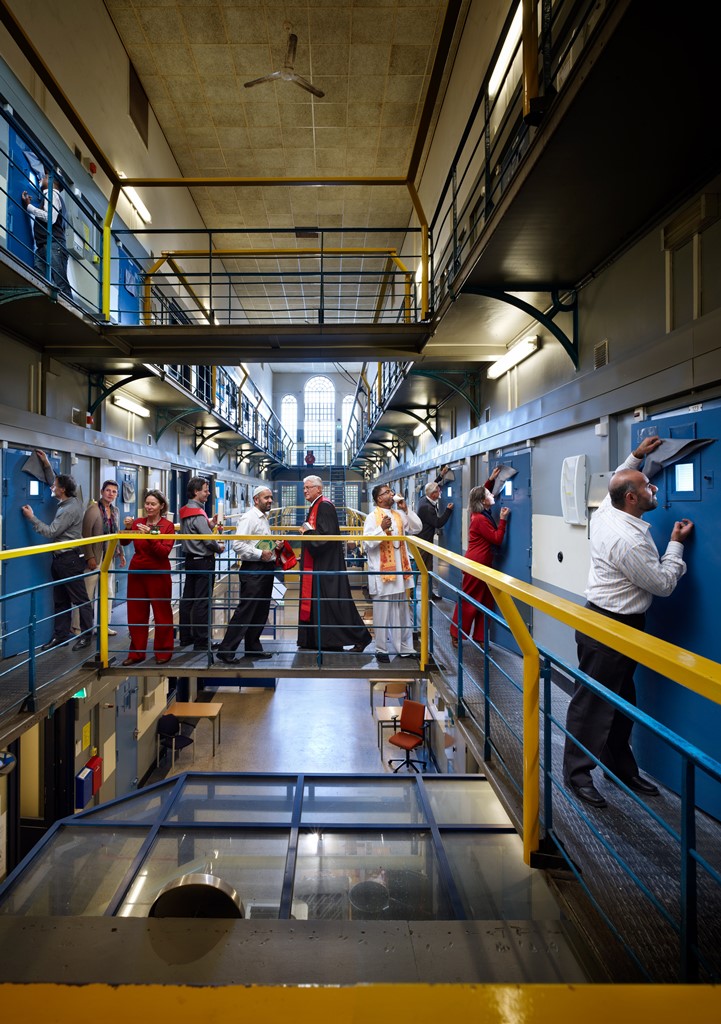
Visiting the prisoner
Chaplains from various religious traditions knock on the cell doors at Noordsingel Prison to engage in conversation with the inmates. They visit regularly, providing friendship and spiritual care.
(Note: Two years after this photo was taken, in 2012, the prison closed and the facilities are now in the final phases of being transformed into a housing complex with gardens.)
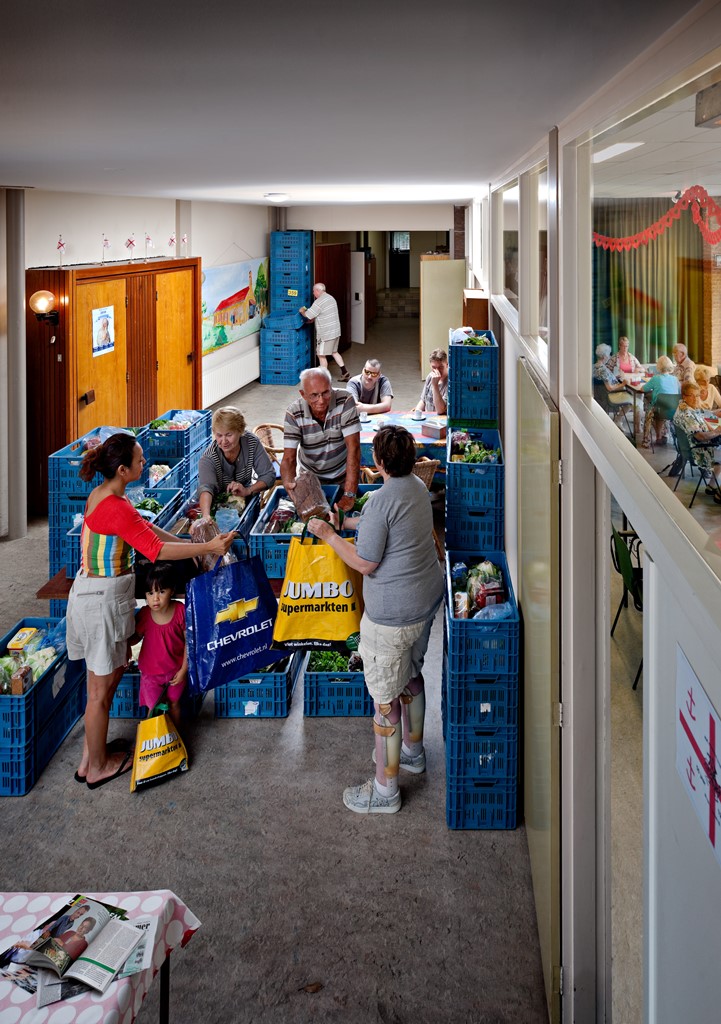
Feeding the hungry
The Rotterdam Food Bank was established by a married couple in 2002 and has since expanded to over fifty distribution points throughout the greater region. Harkening back to the Alkmaar panel, the mise-en-scène includes a man in leg braces and a woman with a clinging child.
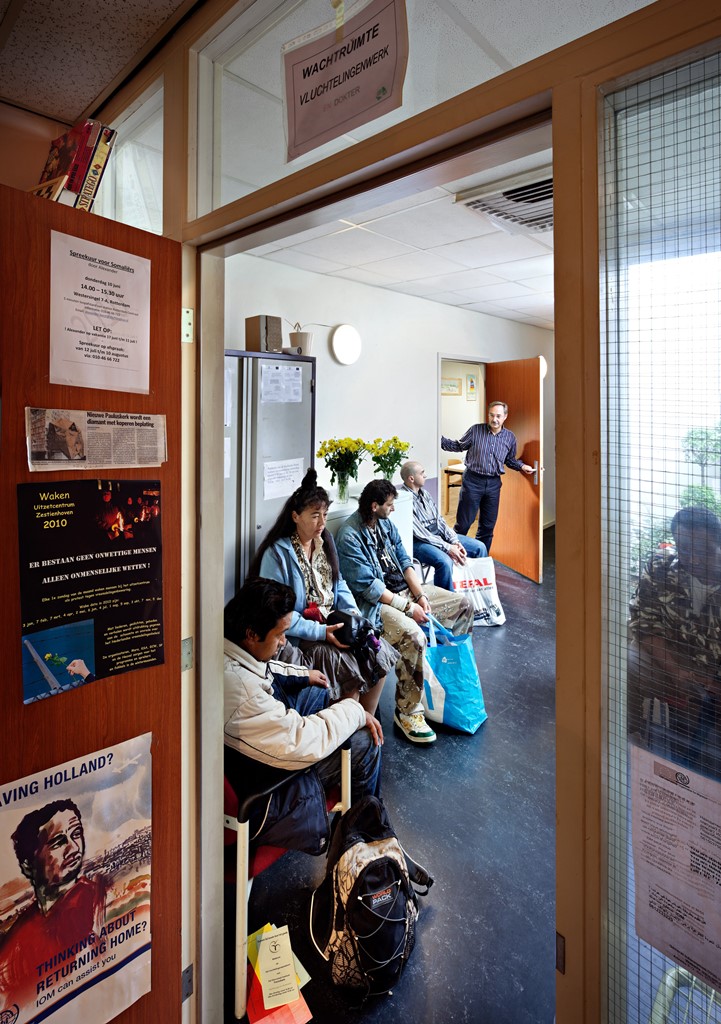
Welcoming the stranger
The Pauluskerk (St. Paul’s Church) in Rotterdam runs a large ministry that serves the city’s undocumented immigrants, providing help with legal aid and health care, accommodations, and sustenance. They give over 2,500 consultations each year, mostly to refugees.
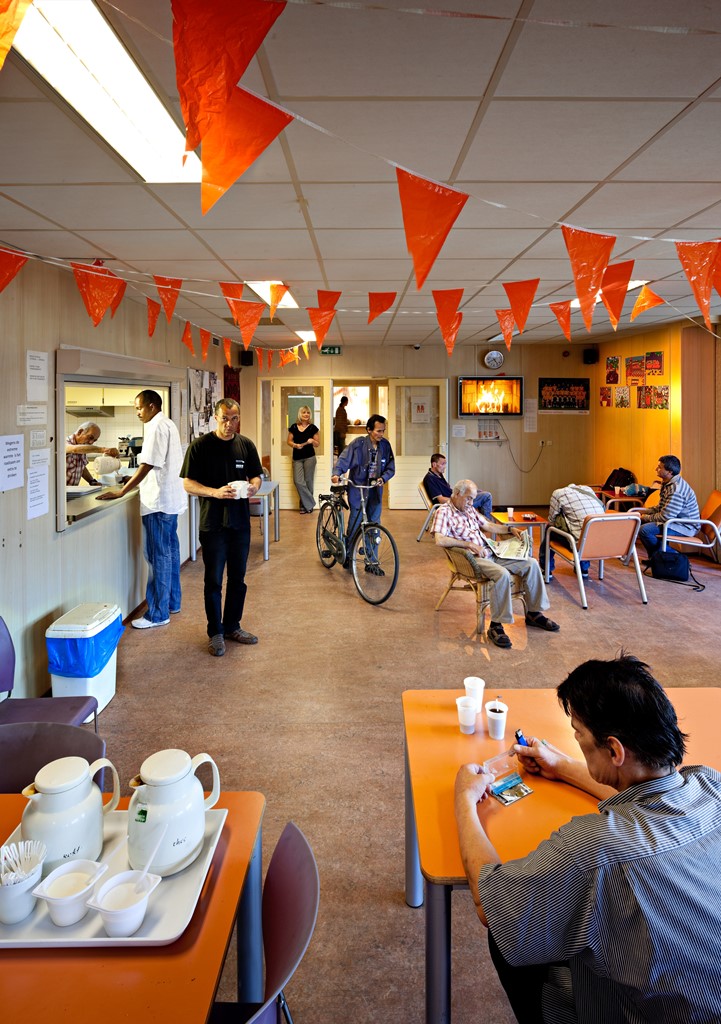
Giving drink to the thirsty
Wolzak sets this act of mercy at the day center of the Nico Adriaan Foundation, a refuge for drug users. The photo, taken inside the lounge, emphasizes the care given by volunteers in their provision of coffee and tea. A digital fireplace crackles on a television monitor on the wall, bringing a modicum of warmth and comfort to the weary ones who have stopped in to rest.
Wolzak’s Works of Mercy concretizes the call to social responsibility, showing examples of what it looks like when community members care for one another. What institutions in your locality are doing important charity and justice work, and how might you support them? Are there any corporal needs in your community not being met, and if so, what first step could you take to change that? Maybe you yourself have a need but are too embarrassed to reach out to anyone. Might you consider allowing someone to serve you?
Charity is often distinguished from justice: charity meets immediate needs, whereas justice reforms institutions or political structures. It’s the difference between addressing symptoms and addressing root causes. Both are needed. Legislative advocacy, yes. But as long as systemic problems persist, services like homeless shelters, refugee sponsorship, clothing closets, soup kitchens and Meals on Wheels, prison visitation, and free medical clinics remain vital.
For the Christian, acts of charity stem from gratitude for the charity Christ has shown us at the cross and from a driving vision of the glorious “new creation” God intends, where all beings flourish in shalom (wholeness, harmony, prosperity). The Bible says love is the summation of all the laws and prophets (Matt. 22:40), the mark of a true Jesus-follower (John 13:35), and that it is expressed through the giving of one’s time, wealth, and other resources. The Seven Works of Mercy is meant not as a checklist to be performed out of a dry sense of duty, but rather as an exciting privilege to be where Christ is, to share God’s gifts, to form mutually enriching friendships, and to bless and be blessed.
Photos of the Alkmaar polyptych courtesy of the Rijksmuseum, https://www.rijksmuseum.nl/en/collection/SK-A-2815/catalogue-entry. Photos of the Rotterdam polyptych courtesy of Thijs Wolzak, http://thijswolzak.nl/. Used by permission.
Victoria Emily Jones is a freelance editor and a writer on Christianity and the arts, blogging at ArtandTheology.org. She serves on the board of the Eliot Society, a Washington, D.C.-based nonprofit that promotes spiritual formation through the arts, and is a contributor to ArtWay and to the Visual Commentary on Scripture, an online biblical art project spearheaded by King’s College London. Follow her on Twitter @artandtheology or on Instagram @art_and_theology.

